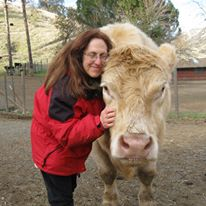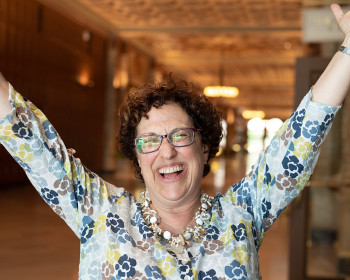Building a Movement to Protect Animals, Humans and the Environment
Open gallery

As children, most of us learned the song Old McDonald’s Farm, and when we think of the animals who are raised to be eaten, that bucolic image of dairy cows grazing in the fields or chickens scratching for bugs and taking dust baths near the barnyard, has remained in our heads as adults. Our “modern” industrialized animal agriculture is nothing like this myth.

The Impact of CAFOs on the Animals
In the United States alone, it is estimated that over 9 billion land animals are slaughtered annually. An estimated 99 percent of farmed land animals in the United States are raised in factory farms, not in the picturesque pastures and small family farms so often depicted in advertising. These megacilities are warehouses, not farms.
For those who may not be familiar, a Concentrated Animal Feeding Operation (CAFO) is an industrial facility where animals are kept until they are large enough and fat enough to send to slaughter. CAFOs were developed in the 1950s in the U.S., when we felt as if we could accomplish anything through industrialization. In Oregon alone, where the Center for Animal Law Studies (CALS) is located, there are 513 permitted CAFOs (as of January 2021).
In CAFOs, animals are crowded into high density confinement and fed a grain-based diet which is brought to the animals, rather than allowing them to forage. Animals are also given hormones, chemicals, and antibiotics, in order to stimulate quicker growth and ward off infections and disease that are caused by keeping them in intensive confinement.
Animals in industrial animal agriculture cannot walk freely, feel the grass beneath their feet, breathe fresh air, or do anything that is natural to their species. To ponder for a moment what those living conditions are like for the animals, imagine being strapped into an economy class seat on an airplane, trapped in your own waste, with putrid air and nothing to occupy your mind, for life.
For instance, pigs raised for pork are as intelligent as dogs are, so with nothing to do with their time and being closely confined, they become frustrated and they take out their aggression on each other by tail biting. The industry’s solution? Cut off their tails rather than give the animals adequate space to move and explore.
When citizens spoke up for the animals and demanded more humane treatment, such as through Proposition 12 in California, rather than investing money into creating a more compassionate living situation for the animals, the pork industry has continued to fight tooth and nail to block the improvements. For too long, legislators and policymakers in the U.S. have caved in to Big Ag, resulting in immense pain and suffering for the more than 9 billion animals raised for food each year in this country. California voters spoke up for farmed animals, and we need more of it.
The Impacts of CAFOs on Humans
The people who work in and as part of industrial animal agriculture often suffer as well. Improving conditions for farmed animals does not only benefit the animals. Doing so also promotes better working conditions for workers, protects neighboring communities, eliminates the use of antibiotics to protect public health, and reduces food-borne illnesses.
Today, many, if not most intensively farmed animals in the U.S. receive regular low levels of antibiotics in feed or water. These antibiotics are used to help producers keep ever-greater numbers of animals in close confinement without the risk of disease outbreaks, and to increase (growth and) productivity. As recently as a few years ago, the Food and Drug Administration and the United States Department of Agriculture estimated that 80% of all antibiotics sold in the U.S. were sold to producers of farmed animals. According to a report by Greater Green, the routine use of antibiotics in intensive livestock farming is linked to a dramatic rise in antibiotic-resistant bacteria, or “superbugs.”
CAFOs also negatively impact the health of nearby communities. CAFOs are commonly built in low income and communities of color, implicating a host of environmental justice issues as I discussed earlier this year in an interview with Naeema Muhammad, Co-Organizing Director of the North Carolina Environmental Justice Network. Naeema described in detail the horrible impact of CAFOs on the health and well-being of people living nearby. No one chooses to live near a CAFO. Rather, CAFOs are commonly built in communities that are judged to lack resources. However, these citizens are starting to fight back with nuisance lawsuits and juries are awarding significant damages to communities taken advantage of by industry.
The people who work in the CAFOs and slaughterhouses suffer from some of the most dangerous working conditions in the U.S., such as: repetitive movement injuries, accidents that result in loss of limbs and sometimes, death, low pay, increased alcoholism and family violence, and an inability to unionize or otherwise impact their working conditions.
The Impact of CAFOs on the Environment
The billions of farmed land animals in the U.S. produce a massive amount of waste on a daily basis, causing a host of environmental consequences. According to a recent Food and Water Watch report, industrial animal agriculture in the U.S. alone produces an estimated 885 billion pounds of manure each year. The industrial-scale production of meat, dairy, and eggs through CAFOs has become a significant contributor to water pollution, air pollution, greenhouse gas emissions, and soil degradation.
Moreover, many people do not realize that around the world, life-sustaining habitat for wild animals is decimated to make room for more industrialized animal agriculture. Livestock production is a major contributor to habitat destruction. A 2015 study predicted that clearing land for livestock production will spur species loss in countries rich in biodiversity. As explained in Science Magazine, the anticipated shift of land from forest to livestock will result in habitat loss so great that it will cause more extinctions than any other factor, particularly when coupled with other deleterious effects of livestock production, including climate change and pollution.
Finally, as the pandemic laid bare, what happens in one part of the globe has ripple effects everywhere. Industrial animal agriculture is a major contributor to climate change. The total emissions from global livestock is 7.1 Gigatonnes of Co2-equiv per year, representing 14.5 percent of all anthropogenic GHG (greenhouse gas) emissions according to The Food and Agriculture Organization (FAO) of the United Nations.
For these reasons, the United Nations Food & Agriculture Organization (FAO) and the United Nations Environment Programme (UNEP) are among those which have called for a plant-based diet as a means to reduce greenhouse gas emissions and to support biodiversity.
How Can You Help?
Each of us can play a role in creating a sustainable and non-harmful food production system, and doing so helps address the intersectional injustices to farmed animals, humans, and the environment. If you’re inspired to learn what you can do to help farmed animals, consider the following:
- As a consumer, demand that the meat, dairy and egg industries catch up with how society feels that farmed animals should be treated: with kindness and compassion.
- Donate to CALS to support our work training the next generation of animal law attorneys to use their valuable legal skills to advance compassion for farmed animals in a legal system that fails to recognize these billions of animals as sentient beings. Whether through my Industrial Animal Agriculture Law course, our Animal Law Litigation Clinic, or the work of our alumni, we advocate for farmed animals every day in our legal work and public education and outreach.
- Support legislation and other advancements to improve farmed animal protection. Whether at the federal, state, or local level, the legal system is lagging far behind how most Americans feel that farmed animals should be treated: humanely.
- Consider how you may stop the suffering of farmed animals in your daily choices, through diet, clothing, lifestyle, and more. Consider a plant-based or alt-protein diet. Ask how you can have a lower carbon footprint and, through your individual choices, reduce or eliminate the suffering of farmed animals.


The Center for Animal Law Studies (CALS) was founded in 2008 with a mission to educate the next generation of animal law attorneys and advance animal protection through the law. With vision and bold risk-taking, CALS has since developed into a world-renowned animal law epicenter, with the most comprehensive animal law curriculum offered anywhere. In addition, CALS is the only program that offers an advanced legal degree in animal law, now offered both in-person and online, and three specialty Animal Law Clinics, including our Animal Law Litigation Clinic–the world’s only legal clinic focused on advancing protections for farmed animals. CALS is a nonprofit organization and is only able to provide these educational opportunities through donations and grants.
More Center for Animal Law Studies Stories
Center for Animal Law Studies is located in Wood Hall on the Law Campus.
MSC: 51
email cals@lclark.edu
voice 503-768-6960
Center for Animal Law Studies
Lewis & Clark Law School
10101 S. Terwilliger Boulevard MSC 51
Portland OR 97219

